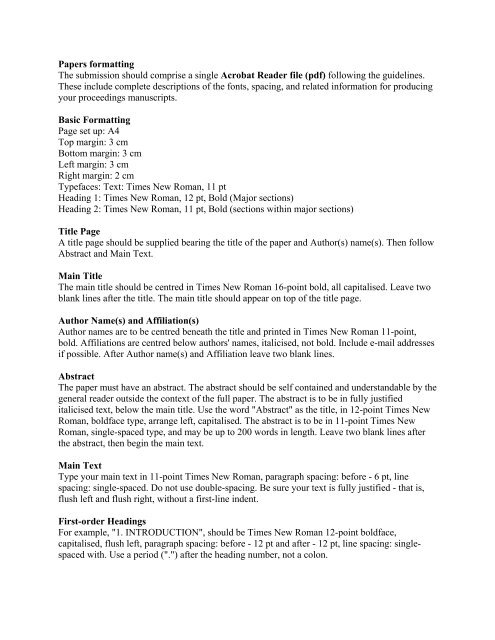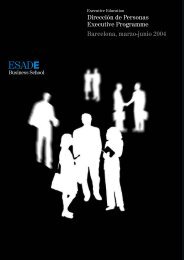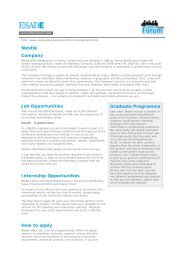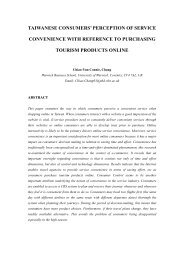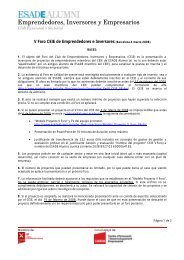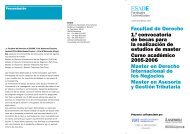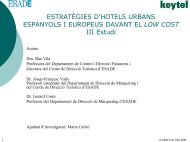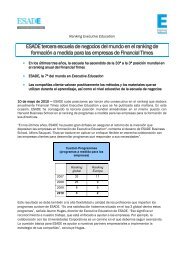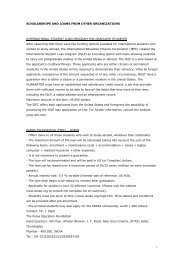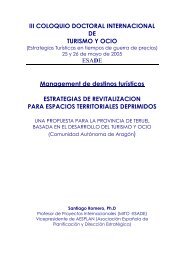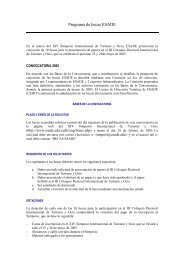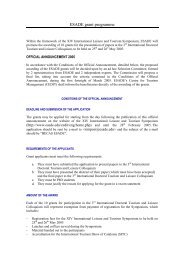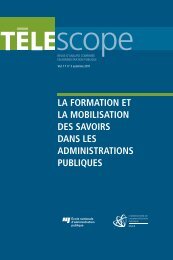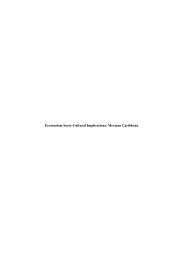Requirements for papers - Esade
Requirements for papers - Esade
Requirements for papers - Esade
You also want an ePaper? Increase the reach of your titles
YUMPU automatically turns print PDFs into web optimized ePapers that Google loves.
Papers <strong>for</strong>matting<br />
The submission should comprise a single Acrobat Reader file (pdf) following the guidelines.<br />
These include complete descriptions of the fonts, spacing, and related in<strong>for</strong>mation <strong>for</strong> producing<br />
your proceedings manuscripts.<br />
Basic Formatting<br />
Page set up: A4<br />
Top margin: 3 cm<br />
Bottom margin: 3 cm<br />
Left margin: 3 cm<br />
Right margin: 2 cm<br />
Typefaces: Text: Times New Roman, 11 pt<br />
Heading 1: Times New Roman, 12 pt, Bold (Major sections)<br />
Heading 2: Times New Roman, 11 pt, Bold (sections within major sections)<br />
Title Page<br />
A title page should be supplied bearing the title of the paper and Author(s) name(s). Then follow<br />
Abstract and Main Text.<br />
Main Title<br />
The main title should be centred in Times New Roman 16-point bold, all capitalised. Leave two<br />
blank lines after the title. The main title should appear on top of the title page.<br />
Author Name(s) and Affiliation(s)<br />
Author names are to be centred beneath the title and printed in Times New Roman 11-point,<br />
bold. Affiliations are centred below authors' names, italicised, not bold. Include e-mail addresses<br />
if possible. After Author name(s) and Affiliation leave two blank lines.<br />
Abstract<br />
The paper must have an abstract. The abstract should be self contained and understandable by the<br />
general reader outside the context of the full paper. The abstract is to be in fully justified<br />
italicised text, below the main title. Use the word "Abstract" as the title, in 12-point Times New<br />
Roman, boldface type, arrange left, capitalised. The abstract is to be in 11-point Times New<br />
Roman, single-spaced type, and may be up to 200 words in length. Leave two blank lines after<br />
the abstract, then begin the main text.<br />
Main Text<br />
Type your main text in 11-point Times New Roman, paragraph spacing: be<strong>for</strong>e - 6 pt, line<br />
spacing: single-spaced. Do not use double-spacing. Be sure your text is fully justified - that is,<br />
flush left and flush right, without a first-line indent.<br />
First-order Headings<br />
For example, "1. INTRODUCTION", should be Times New Roman 12-point boldface,<br />
capitalised, flush left, paragraph spacing: be<strong>for</strong>e - 12 pt and after - 12 pt, line spacing: singlespaced<br />
with. Use a period (".") after the heading number, not a colon.
Second-order Headings<br />
For Example, "2.2 Title page" should be Times New Roman 11-point boldface, initially<br />
capitalised, flush left, paragraph spacing: be<strong>for</strong>e - 11 pt and after - 11 pt, line spacing: singlespaced<br />
with.<br />
Do NOT Use Third-order Headings<br />
Third-order headings, are strongly discouraged. However, if you must use them, use 10-point<br />
Times, italics, initially capitalised, flush left, preceded by one blank line, followed by your text<br />
on the next line.<br />
Footnotes<br />
Use footnotes sparingly (or not at all!) and place them at the bottom of the page on which they<br />
are referenced. Use Times New Roman 8-point type, single-spaced. To help your readers, avoid<br />
using footnotes altogether and include necessary peripheral observations in the text (within<br />
parentheses, if you prefer, as in this sentence).<br />
Figures and Tables<br />
Figures should be numbered consecutively as they appear in the text. Figures that contain only<br />
textual rather than diagrammatic in<strong>for</strong>mation should be designated tables. Tables should be<br />
numbered consecutively as they appear in the text.<br />
References<br />
References in the text are indicated by authors' names and year of publication in parentheses. If a<br />
referenced paper has three or more authors the reference should always appear as the first author<br />
followed by et al. The references are listed alphabetically at the end of the manuscript. Journal<br />
titles should not be abbreviated.<br />
Below you can find examples of references.<br />
Journal<br />
Ciborra, C. and G. Lanzara (1994). Formative Contexts and In<strong>for</strong>mation Technology:<br />
Understanding the Dynamics of Innovation in Organisations. Accounting, Management &<br />
In<strong>for</strong>mation Technology, 4 (2), 61-86.<br />
Book<br />
Avison, D.E. and G. Fitzgerald (1995). In<strong>for</strong>mation Systems Development: Methodologies,<br />
Techniques and Tools. 2nd Edition. McGraw-Hill, London.<br />
Conference paper or contributed volume<br />
Kautz, K. and T. Mcmaster (1994). The failure to introduce systems development methods: A<br />
factor-based analysis. In Proceedings of the IFIP TC8 Working Conference on Diffusion,<br />
Transfer and Implementation of In<strong>for</strong>mation Technology (Levine, L. Ed.), p. 275, IFIP<br />
Transactions A-45, North-Holland, Amsterdam.
Unpublished reports/theses<br />
Wrycza, S. (2001). A Comparative Analysis Methodology <strong>for</strong> New Economy Indicators,<br />
Research Report RR9, Department of In<strong>for</strong>mation Systems, University of Gdansk.<br />
Submission length<br />
The expected length of the research <strong>papers</strong> is a maximum of 20 pages, including abstracts,<br />
attachments, charts (within the text) and bibliography.


